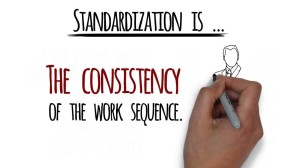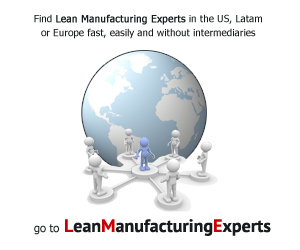Lean performance: For no surprises, standardize it
Lean performance: For no surprises, standardize it
Why standards and consistency are key for peak performance in a lean initiative.
Earlier this year we explored the importance of four basic building blocks for success in lean manufacturing and how technology can make success much easier to achieve. I have seen these building blocks establish a foundation that naturally leads to improved lean performance, if everyone at a plant embraces them.
To recap, the four building blocks are: embracing visibility, providing value to the end user, ensuring ease of use, and providing a mechanism for feedback. Visibility and transparency means using technology to give high visibility and complete transparency in the plant. It is essential that plant workers see the abnormalities that are causing production issues and have the information they need to address them quickly. Visibility doesn’t mean that I receive a report every day (yesterday’s news). It means that current plant status and activities are seen in real time by everyone.
Value to the end user means that manufacturing systems technology should be a tool at the hands of the workforce, rather than an added task. Ease of use is vital because the simpler the technology is to use, the quicker it will be adopted and the more it will be utilized. Finally, any manufacturing system must be able to provide instant feedback. Because information loses value over time, employees benefit most from seeing the immediate effects of their work. Problems must also be identified quickly so that they can be solved with less downtime. All of these are important to effectively lay the groundwork for a sustainable lean culture, as opposed to a short-lived lean project.
As you use technology to establish these four building blocks within your plants, there is another quintessential element that’s needed to scale and accelerate the derived benefits: standardization. We are seeing rapid changes in manufacturing, with many companies expanding through the acquisition of multiple plants, often in different states or different countries – and each with its own existing software systems. Given this evolutionary expansion, manufacturers often find themselves with a wide variety of manufacturing and management systems across their plant sites. This creates significant challenges to overcome for companywide lean performance. Standardization therefore becomes an essential element to fully leverage the building blocks of lean.
Standardization has developed negative connotations for longtime managers and executives in the manufacturing sector. In the past, typical approaches to standardization were costly and risky. For example, standardizing a system meant ripping out the old system and installing a total replacement. The cost of doing that across multiple plants could drastically affect a company’s bottom line.
Plus, production delays, work stoppages, and having to retrain plant workers add to the inconvenience, while the risk of losing continuity and important data is high. In many cases, implementing new systems across multiple locations causes such disruption that manufacturers simply give up and go back to the old system.
However, I believe that frustration with implementation should not deter manufacturers from seeking low-cost and low-risk ways to achieve standardization or from appreciating its long-term value. Standardization at its best equals simplification. If technology is easy to use and understand, its use will increase. Expanded use of technology can lead not only to production of better and more accurate data but also to easier and better interpretation of that data. Effective lean performance is virtually impossible when a manufacturer is working with 10 different systems, all of them in their own silos.
In every case, the goal of plant operators is to lower the operations threshold to a single common denominator that is easy for everyone to use as they input and access data.
A new era of standardization, with help from the cloud
Fortunately, new technologies are coming online that allow manufacturers to achieve standardization at low cost and low risk but with high reward. Cloud-based technology enables companies to work across existing legacy systems, tying operations together and providing full-plant insights and analysis in real time.
Uniting systems through cloud-based technology not only avoids unnecessary costs and risks, but also it dramatically simplifies the application and deployment of lean performance across an entire organization (regardless of how many plants there are in the network). The cloud provides a way to manage the shop floor in a standard fashion across the board, whether the plant is in Utah, Ohio, or Sweden.
There tends to be hesitancy in the industry when people are confronted with cloud-based solutions, but manufacturers must move past their fear of the cloud. There needs to be more acceptance of the cloud’s value and security, given that it provides a means to work across and tie into many different manufacturing and financial systems. Cloud technology allows manufacturers to pull everything together on a national or global level and allows the sharing of best practices across entire plant networks.
Moving forward, the versatility of the cloud will become the new standard in lean execution solutions for manufacturing. The right system provides a standard language, previously unseen data and insights, and is usable by all employees on the plant floor. All workers on the same page with access to the same information and visibility of problems through a standardized system, will drive accountability and engagement that measurably improve operations.
Empowering true lean performance
For all of the talk about lean in manufacturing, at its core, true lean performance comes from empowering workers to locate and solve problems quickly. A manufacturer’s mandate is to produce quality products and maintain efficient processes. That means the enemies of production are downtime, stoppages, and breakdowns. In the past, finding problems was often done post-mortem, long after the problem occurred. In some cases, problems were never identified.
Automation hasn’t removed human interaction from manufacturing; instead, it has made human actions essential to optimize performance. But optimized performance isn’t good enough if it is isolated to a single production line or manufacturing site. The vital choice is to standardize across the company to allow the benefits to be scaled and accelerated.
The industry must come to understand that full transparency – the ability of the entire workforce, from plant-floor workers to managers and executives, to see everything that is happening at every workstation – gives everyone the confidence to confront problems and collaborate on solutions. Transparency can encourage a cultural shift of openness to identify problems without fear of blame or reprisal.
These building blocks of lean, including standardization, are essential if manufacturing is going to thrive in the future. Manufacturers provide products and jobs critical to a functioning, efficient world. We must not forget that people are the key source of improvement and innovation. Lean performance can’t be done on paper outside of the operations of a plant or a plant network. It must be done through the engagement and empowerment of a strong, confident workforce.
Companies are more crippled than they know
Recently, I paid a visit to manufacturer in the kitchen and bathroom fixtures industry. Before the meeting, a representative mentioned that the company already had a process in place for recording problems. I was assured that the manufacturer had clear visibility of problems and abnormalities. Frankly, I wondered why we were called in, as it sounded like things were working fine.
The first thing my team did was an audit. It turned out to be an eye-opener for the company’s team. Everything they understood to be providing relevant data was inaccurate and a day late at best. And they were using different systems in different plants across the network. After the audit, team members agreed that they didn’t have visibility and that their data wasn’t accurate. That’s when we started to get to work.
Visibility means that everyone in the plant knows the precise status of operations, maintenance, resources, and priorities. Lean performance means you can see problems and fix them in real time. Standardization means you can perform those fixes across a multisite network.
Companies that don’t ensure that these are in place in their facilities are at great risk in today’s fast-paced manufacturing environment. They are also losing money.

 News, training, experts opinion, bibliography, software and everything about Lean world.
News, training, experts opinion, bibliography, software and everything about Lean world.

